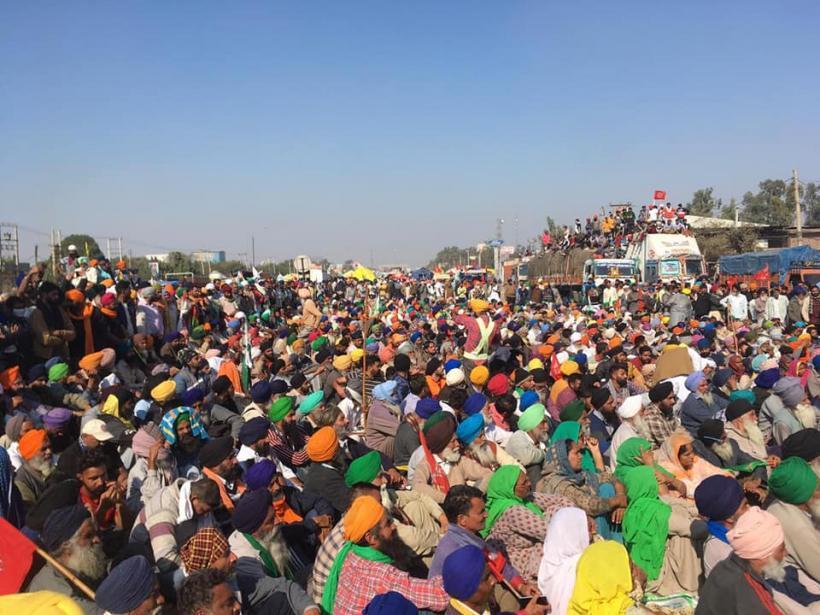What the Farmers Movement Has Achieved So Far

File Image
Ever since a grisly murder was discovered at the Singhu Border protest site, many people are clamouring to end the farmer protests, wilfully ignoring the many gains it has clocked. As India trembles under a bruising authoritarian-style government, the farmer’s protest has come to symbolise the power of public unity against a government that refuses to give even a quarter to dissent.
The protesters borrowed the sit-in style from the anti-Citizenship Amendment Act movement to fashion a new vocabulary of protest that has placed dissent at the heart of Indian politics. They have proved wrong those who predicted the demise of mass protests after the Bharatiya Janata Party (BJP) came to power in 2014. The farmers have now run the longest ever anti-government movement, something that was said could never happen. The government cannot turn the clock back on these protests, even if, alongside middle-class India, it keeps questioning their “very existence”.
Unlike the TV-watching urbanites, farmers have shown they are not in awe of state power. They have tackled hostile police cases, state repression, and done so fearlessly. In this way, they could expose the nature of the Indian State. They revealed how obstinate the central government is, which refuses to withdraw even those laws it hastily and undemocratically passed without debate or discussion. The farmers also demonstrated how far the State can go to victimise those who disagree with its policies.
The farmers’ movement can be credited with weaning many TV viewers away from mainstream news outlets. It has encouraged people to explore alternate sources of news and information. That this protest survives is a testament to changing attitudes towards the media, especially in rural north India. When most media painted farmers and their supporters as anti-nationals, the farmers launched a magazine, used social media, and often barred “godi media” from protest sites. Over time, many people realised political and corporate interests have hijacked the media. The farmers alone raise the critical question of media ownership from their public platforms.
Farmers have made Hindu-Muslim rapprochement seem possible in the Muzaffarnagar district of Uttar Pradesh, a region torn by communal violence in 2013. It is yet unknown what the voting patterns in 2022 will be like, but the positive socio-cultural impact of the farmer movement cannot be underplayed. In public meetings, farmer leaders speak of communal amity and unity and brotherhood (ekta, bhaichara) between Haryana, Rajasthan and Punjab, states that often were at loggerheads over water-sharing and other issues. Farm leaders have repeatedly warned people in rural areas against politics that divide people in the name of religion and caste. Like the anti-CAA movement, it has brought people together, which means it did the work that politics and leaders are supposed to do. Oddly, even states they did not expect support from have backed them: Farmers from Gujarat and Himachal Pradesh joined them, for example, testifying to the broad appeal of their demands.
The farmer movement overcame the 26 January fiasco, when many protesters deviated from the route fixed for a tractor rally in Delhi and landed in skirmishes at the Red Fort. The media went on overdrive, calling it a deliberate attack inspired by religion and separatism. Farmers could regroup despite all this because their movement had encouraged people to be more sceptical and discerning media consumers. They taught people how to recognise pro-government news as propaganda, who saw through TV anchors calling the farmers ‘terrorists’ or ‘Khalistani’.
Earlier this month, a vehicle owned by BJP leader and Union Home Minister Ajay Mishra Teni mowed down three farmers and a journalist at Lakhimpur Kheri in Uttar Pradesh. At first, the ruling party sought to project this as an attack by farmers on its party workers. Soon, videos of the incident went viral, showing the vehicle speed over farmers. The on-ground narrative changed, and the BJP, whose members allegedly drove the vehicles, now embodies hubris and oppression in parts of rural Uttar Pradesh. It was a significant change from earlier when the claims of BJP leaders were gospel, even if contrary evidence came to light.
The farmers have brought agriculture to the forefront, along with all its associated ills. They understand the country is getting corporatised along with its fields and are pressuring the State to change agriculture and the economic structure. They want more diversified cropping, better water management, less dependence on farm machinery, more robust public services, and better chances for employment and education for the youth.
The BJP has often projected the farmers’ protest as driven by wealthy and elite farmers. However, no mass movement can be spearheaded by the most marginalised forces; the farm movement is no exception. This agitation has got the country talking about the excluded and marginalised sections. So, we hear about women leaders and their double burden from the protest platforms, along with slogans of farmer-worker solidarity, Dalit-Jat Sikh unity, on the problems of agricultural labour, etc. The oppressed among the assertive section of society are out on the streets, which is giving the most marginalised a shot at visibility. For the first time in decades, anti-communalism and pro-democracy slogans are heard from stages as the farmers expand the scope of their protest. Would Punjab have got a chief minister who is a Dalit if Punjab’s Dalits had not raised their concerns against the backdrop of this movement? Unlikely. In the stratified Indian society, those at the margins have got a chance to be heard.
The 77th round of the NSSO shows the stark picture of agriculture today. The share of income from non-farm activities (primarily manual labour) is growing. Earlier, it was mainly those who owned 1-2 acres who performed labour outside the farms, but now the proportion of those with 5 acres or more land, who perform manual labour, is growing. The growth of the labour component is a signal of people getting ousted from agriculture. Understanding this has allowed farmers to create an anti-corporate, anti-fascist ambience. Not just the repeal of the three farm laws, they want human rights respected, MSP for more crops, and oppose communal politics. They are questioning neoliberal policies, often identifying economic problems more effectively than many expert commentators. For example, they hold corporatisation of rural life responsible for growing inequality and poverty. As farmers expose the strong corporate grip over the farm sector, those who oppose them are chafing over the existence of a political Left. However, the farmers have shown the relevance of left politics even if there are few communist MPs in Parliament.
In this environment of opposition, the government has desisted from publishing the four new labour codes. Even the NRC hasn’t been launched despite rhetoric about illegal immigrants. The farmers’ gains are many, and one may be that the ruling party will try to ‘reconcile’ with them (in its own way). After all, in Uttar Pradesh, this movement is a sword of Damocles, hanging over the forthcoming Assembly election and the BJP’s political fortunes.
In its year-long existence, farmers have shown movements only sustain with sacrifice. India has sacrificed more than 650 farmers to the travails of this long-drawn protest, people who would have been saved had the government withdrawn its hastily-passed farm laws.
Get the latest reports & analysis with people's perspective on Protests, movements & deep analytical videos, discussions of the current affairs in your Telegram app. Subscribe to NewsClick's Telegram channel & get Real-Time updates on stories, as they get published on our website.























